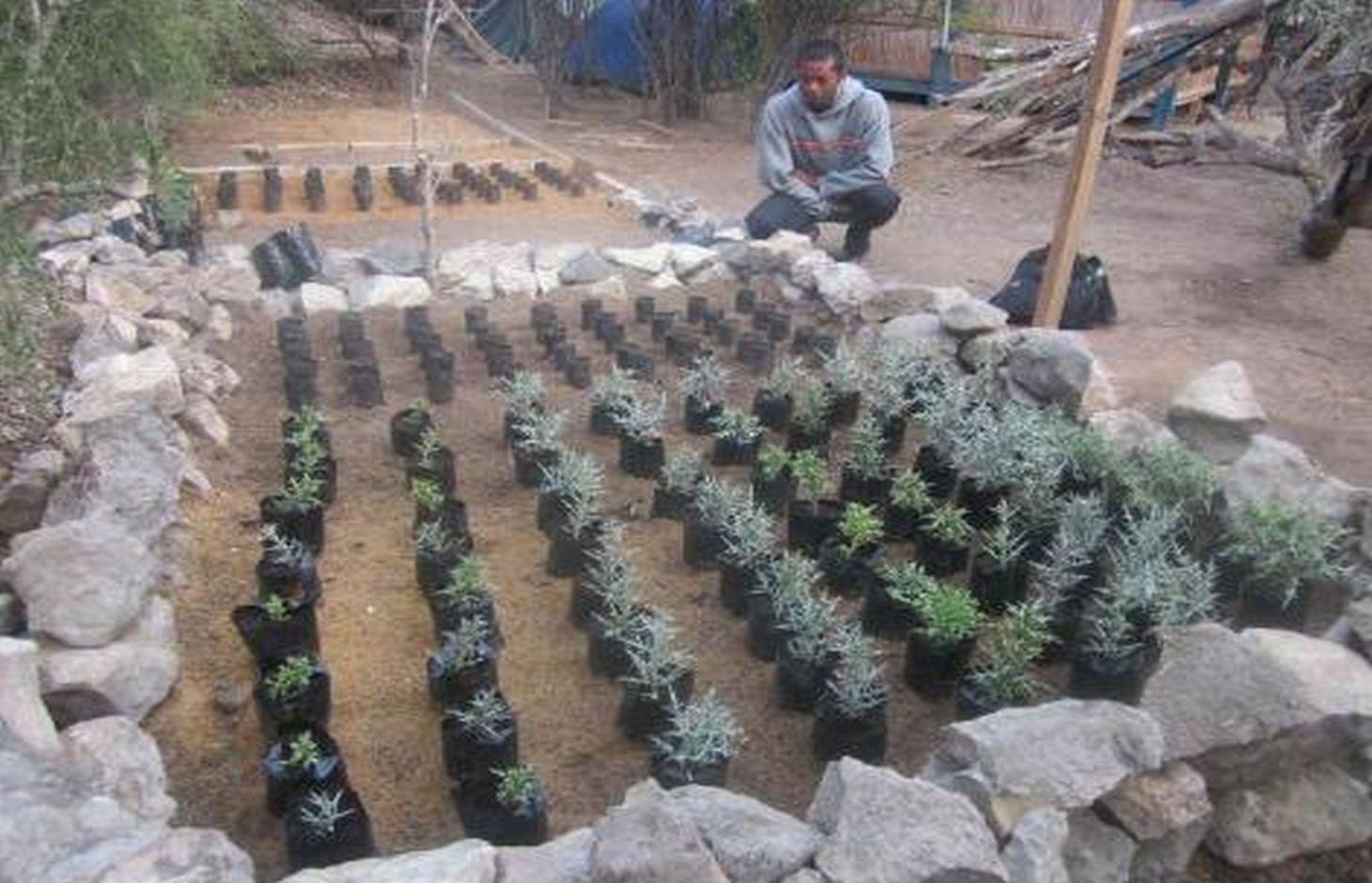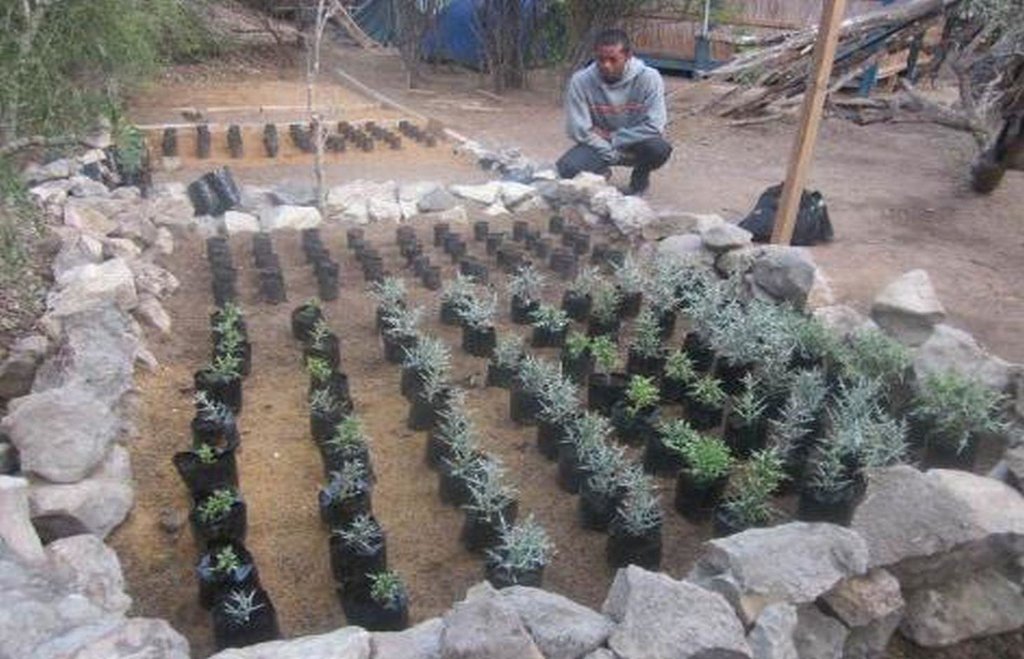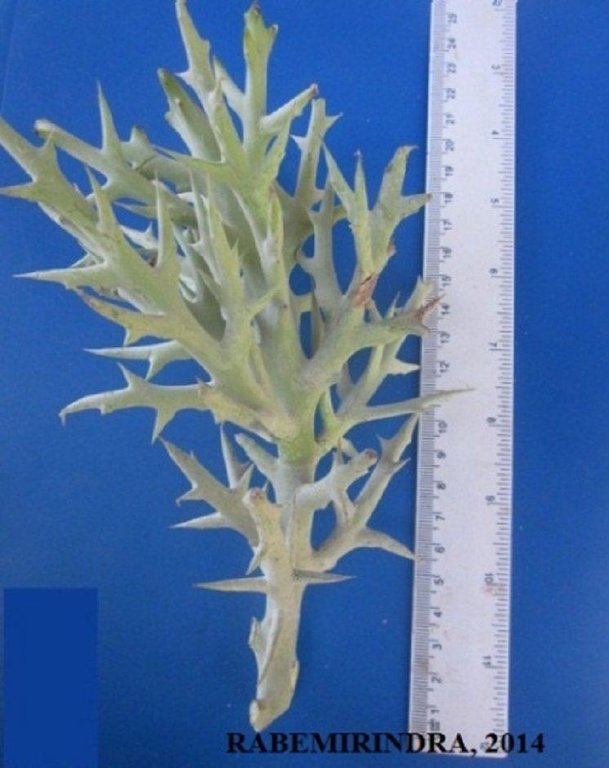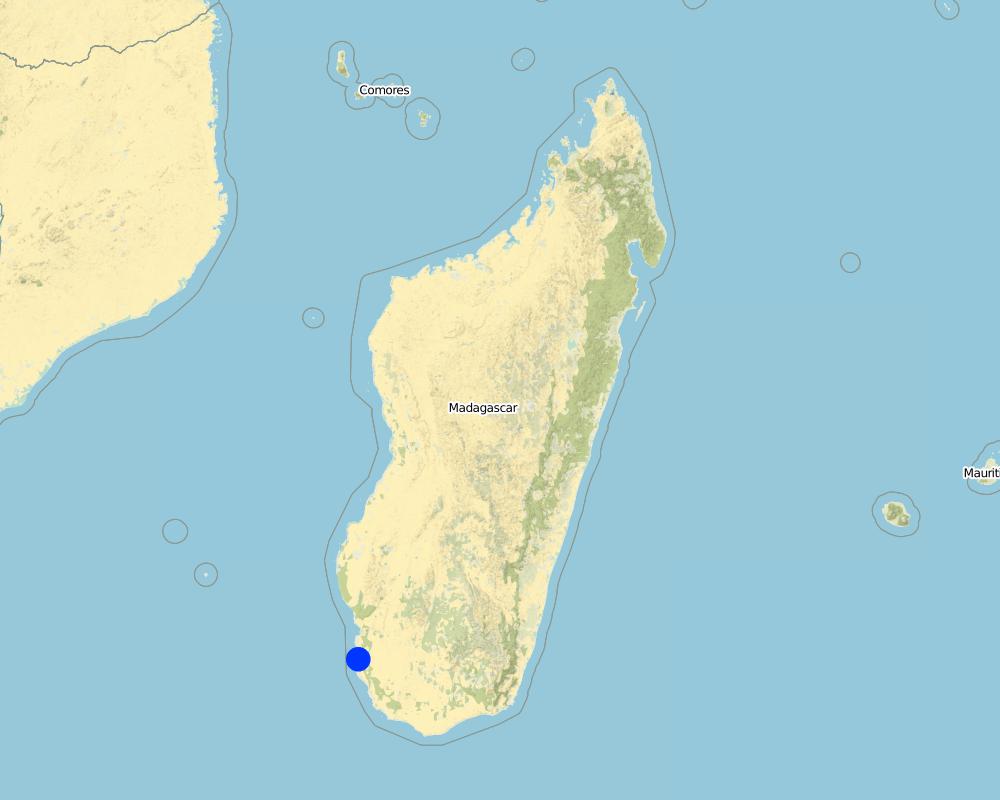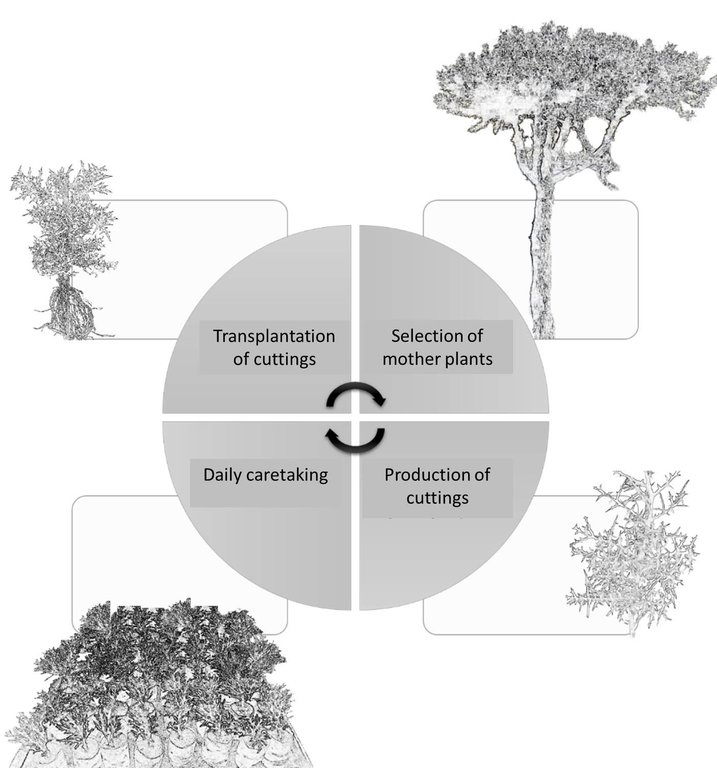Sustainable propagation of the fodder tree Euphorbia stenoclada (“samata”) [Madagascar]
- Creation:
- Update:
- Compiler: Johanna Goetter
- Editor: –
- Reviewers: David Streiff, Fabian Ottiger, Alexandra Gavilano
technologies_1677 - Madagascar
- Full summary as PDF
- Full summary as PDF for print
- Full summary in the browser
- Full summary (unformatted)
- Sustainable propagation of the fodder tree Euphorbia stenoclada (“samata”): March 9, 2017 (inactive)
- Sustainable propagation of the fodder tree Euphorbia stenoclada (“samata”): May 3, 2017 (inactive)
- Sustainable propagation of the fodder tree Euphorbia stenoclada (“samata”): May 3, 2017 (inactive)
- Sustainable propagation of the fodder tree Euphorbia stenoclada (“samata”): Sept. 5, 2019 (public)
View sections
Expand all Collapse all1. General information
1.2 Contact details of resource persons and institutions involved in the assessment and documentation of the Technology
SLM specialist:
Herinavalona Rabemirinra
University of Antananarivo
Madagascar
SLM specialist:
Yeddiya Ratovonamana
World Wildlife Fund (WWF Toliara)
Madagascar
SLM specialist:
Goum O. Antsonantenainarivony
University of Antananarivo
Madagascar
Name of project which facilitated the documentation/ evaluation of the Technology (if relevant)
Book project: Making sense of research for sustainable land management (GLUES)Name of project which facilitated the documentation/ evaluation of the Technology (if relevant)
Sustainable Landmanagement in south-western Madagascar (SuLaMa / GLUES)Name of the institution(s) which facilitated the documentation/ evaluation of the Technology (if relevant)
Brandenburg Technical University (btu) - GermanyName of the institution(s) which facilitated the documentation/ evaluation of the Technology (if relevant)
University of Antananarivo - MadagascarName of the institution(s) which facilitated the documentation/ evaluation of the Technology (if relevant)
World Wide Fund for Nature (WWF) - Switzerland1.3 Conditions regarding the use of data documented through WOCAT
The compiler and key resource person(s) accept the conditions regarding the use of data documented through WOCAT:
Yes
1.5 Reference to Questionnaire(s) on SLM Approaches (documented using WOCAT)
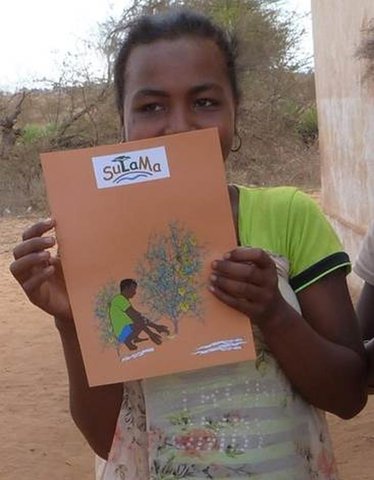
Increasing environmental awareness using comic-style illustrations as a … [Madagascar]
Communicating and transferring scientific results and recommendations about sustainable land management to local people
- Compiler: Tobias Feldt
2. Description of the SLM Technology
2.1 Short description of the Technology
Definition of the Technology:
Propagation of “samata” cuttings for long-term provision of supplementary livestock fodder to reduce the pressure on natural vegetation.
2.2 Detailed description of the Technology
Description:
The succulent evergreen tree Euphorbia stenoclada (“samata”) is the most important dry season fodder resource on the coastal plains grazing grounds in the Mahafaly Plateau region. To increase production, samata can be vegetatively propagated with cuttings raised in a nursery. The advantages are: (a) protection against livestock, (b) selection of the most appropriate planting stock to propagate and (c) easy watering. Cuttings should only be taken from mature trees 7-10 years old and 3-4 m high. The mother plants should be healthy, with few spines, and no previous cuttings taken. Cuttings are taken at the upper nodes of the branches, approximately 20-25 cm long and 0.5-1.5 cm diameter. Transport of the cuttings to the nursery should be carried out in the morning to avoid heat. For effective rooting, the cutting is planted 5 cm (1-2 nodes) into a humid substrate in a plastic pot or directly into the ground. Best results are achieved using white sea sand mixed with some organic material. Cuttings should be raised in a sunny location. During the first 15 days, the cuttings need to be watered once every morning. For the next 3-4 months, they need watering every second morning. 24 hours before transplantation from the nursery to the final destination, the cuttings should be abundantly watered. Rooted cuttings are transplanted into pits of 10 cm diameter and 15 cm depth, filled with the same substrate as used in the nursery. For 15 days, the transplants are watered on a daily basis, and afterwards every second day. After 30-45 days, the transplants are ready to survive without further care. If the planting location is open to roaming livestock, the cuttings need protection.
Purpose of the Technology: The samata tree naturally reproduces by seeds as well as by vegetative reproduction. However the German funded SULAMA research project has had most success with multiplication of the local variety with cuttings. This form of propagation is preferable as it is much faster and gives higher survival rates of the individuals: neither does it need much planting material, equipment or technical knowledge. Providing the villagers with the know-how, and assisting them to create local samata-nurseries, makes this technology promising. SuLaMa-WWF started this technique in April 2015, establishing 5 nurseries with 2,000 trees each (3 with village communities, 2 with local schools).
Establishment / maintenance activities and inputs: On the coastal plain of the Mahafaly plateau region, the climatic and edaphic conditions do not support livestock raising based mainly on grasses. For 6-7 months, the herders are dependent on supplementary fodder plants, especially samata. The tree is fed by cutting its branches and slicing them. However pressure on this resource has led to depletion of stocks around many villages: this results from increasing demand and reduced supply. Higher demand is the result of changed herd movements, especially a shorter transhumance period. Lower supply is attributed to decreased precipitation, overuse of trees leading to poor regeneration or even the death of trees, and reduced samata areas due to the expansion of private crop fields. The overuse of trees is triggered by the overall scarcity of this resource as well as an ongoing privatization of the historically common land resources.
2.3 Photos of the Technology
2.5 Country/ region/ locations where the Technology has been applied and which are covered by this assessment
Country:
Madagascar
Region/ State/ Province:
Atsimo-Andrefana, Toliara
Further specification of location:
Toliara II, Beheloka
Specify the spread of the Technology:
- evenly spread over an area
If precise area is not known, indicate approximate area covered:
- 10-100 km2
Comments:
Application ongoing, the envisaged implementation area might be up to 1,000 km².
Map
×2.6 Date of implementation
If precise year is not known, indicate approximate date:
- less than 10 years ago (recently)
2.7 Introduction of the Technology
Specify how the Technology was introduced:
- during experiments/ research
- through projects/ external interventions
Comments (type of project, etc.):
Project started with experimental trials of multiplication by cuttings in February 2014, first capacity development for land users through workshops on propagation technique in May 2015.
3. Classification of the SLM Technology
3.2 Current land use type(s) where the Technology is applied

Cropland
- Annual cropping
- Tree and shrub cropping
Annual cropping - Specify crops:
- cereals - maize
- root/tuber crops - sweet potatoes, yams, taro/cocoyam, other
- root/tuber crops - cassava
Tree and shrub cropping - Specify crops:
- fodder trees (Calliandra, Leucaena leucocephala, Prosopis, etc.)
- cactus, Euphorbbia stenoclada, samata trees
Number of growing seasons per year:
- 1
Specify:
Longest growing period from month to month: June - September

Grazing land
Extensive grazing:
- Semi-nomadic pastoralism
Intensive grazing/ fodder production:
- Cut-and-carry/ zero grazing
Comments:
Major cash crop annual cropping: Maize
Major food crop annual cropping: Cassava
Other crops annual cropping: Sweet potato
Major cash crop tree/shrub cropping: Samata (Euphorbia stenoclada)
Other crops tree/shrub cropping: Cactus
Major land use problems (compiler’s opinion): : Climatic constraints (especially low and erratic precipitation), deforestation, forest degradation, soil degradation, overgrazing, loss of arable land, fragmentation, low availability of surface and (very saline) ground water, privatization of common pool resources.
Major land use problems (land users’ perception): Climatic constraints, loss of arable land, low availability of animal fodder, soil degradation, low availability of surface and (very saline) ground water.
Semi-nomadism / pastoralism: Yes
Cut-and-carry/ zero grazing: Yes
Type of cropping system and major crops comments: samata trees are both found on the grazing area (naturally), as well as on agricultural fields (naturally, transplanted). Main reason for transplanting to fields however not shade/other positive interaction with crops, but for property rights reasons.
Livestock density: 1-10 LU /km2
3.4 Water supply
Water supply for the land on which the Technology is applied:
- rainfed
3.5 SLM group to which the Technology belongs
- improved plant varieties/ animal breeds
- Propagation of fodder plants
3.6 SLM measures comprising the Technology

vegetative measures
- V1: Tree and shrub cover
Comments:
Main measures: vegetative measures
Type of vegetative measures: in blocks
3.7 Main types of land degradation addressed by the Technology

biological degradation
- Bc: reduction of vegetation cover
- Bh: loss of habitats
- Bq: quantity/ biomass decline
Comments:
Main type of degradation addressed: Bc: reduction of vegetation cover, Bq: quantity / biomass decline
Secondary types of degradation addressed: Bh: loss of habitats
Main causes of degradation: deforestation / removal of natural vegetation (incl. forest fires) (Slash&burn, charcoal production, overgrazing and grazing in forests), overgrazing (overexploitation of samata-trees), change of seasonal rainfall, droughts, other natural causes (avalanches, volcanic eruptions, mud flows, highly susceptible natural resources, extreme topography, etc.) specify (cyclones), population pressure (ca. 3% / year), poverty / wealth (Extreme poverty, subsistence and low economic development), education, access to knowledge and support services (limited access to improved tecniques for agriculture and livestock keeping)
Secondary causes of degradation: crop management (annual, perennial, tree/shrub) (Non-optimized crops), over-exploitation of vegetation for domestic use (Overexploitation of wild plants), Heavy / extreme rainfall (intensity/amounts), wind storms / dust storms, land tenure (privatization of formerly open access rangeland leading to increased pressure on still open access samata-trees), inputs and infrastructure: (roads, markets, distribution of water points, other, …), war and conflicts (armed cattle rustling on neighboring plateau let to new transhumance pattern towards implementation region, thus higher pressure on fodder resources), governance / institutional (limited access to improved tecniques for agriculture and livestock keeping)
3.8 Prevention, reduction, or restoration of land degradation
Comments:
Main goals: mitigation / reduction of land degradation, rehabilitation / reclamation of denuded land
Secondary goals: prevention of land degradation
4. Technical specifications, implementation activities, inputs, and costs
4.1 Technical drawing of the Technology
Technical specifications (related to technical drawing):
Multiplication of samata trees through cuttings preferably in the cold season from June to August: (1) Selection of suitable mother plants: adult trees 7-10 years old, 3-4 m high, good phytosanitary condition, low in spines, without previous cuttings taken (2) Taking cuttings with a sharp knife at the upper nodes of the branches, approximately 20-25 cm long and 0.5-1.5 cm in diameter. To ensure the survival of the mother tree, at least 10 branches should remain uncut. Transportation of the cuttings to the nursery takes place preferably in the early morning to avoid heat. (3) Daily care of cuttings in nurseries till the roots are well-established. The cuttings are planted 5 cm deep (1-2 nodes) into a humid substrate in a plastic bag or pot, filled with a substrate of white ocean sand mixed with some organic material, for example dung (75% sand, 25% dung). During the first 15 days, the cuttings need to be watered once every morning. For the next 3-4 months, they need watering every second morning. Shade has to be avoided. (4) Transplanting cuttings: 24 hours before transplanting, the cuttings need to be abundantly watered. The rooted cuttings are transplanted into holes of 10 cm diameter and 15 cm depth, filled with the same substrate used in
the nursery. For 15 days, the transplants are watered on a daily basis, and afterwards every second day. After 30-45 days, the transplants will be ready to survive without any further human attention.
Technical knowledge required for field staff / advisors: low
Technical knowledge required for land users: low
Main technical functions: increase of biomass (quantity)
Aligned: -contour
Vegetative material: T : trees / shrubs
In blocks
Vegetative material: T : trees / shrubs
Number of plants per (ha): 300
Spacing between rows / strips / blocks (m): 5
Vertical interval within rows / strips / blocks (m): 5
Width within rows / strips / blocks (m): 0.3
Trees/ shrubs species: Euphorbbia stenoclada, planted cuttings (artificial vegetative multiplication)
Slope (which determines the spacing indicated above): 0%
Gradient along the rows / strips: 0%
Author:
RATOVONAMANA R. Yeddiya, UNIVERSITE D’ANTANANARIVO FACULTE DES SCIENCES DEPARTEMENT DE BIOLOGIE ET ECOLOGIE VEGETALES
4.2 General information regarding the calculation of inputs and costs
other/ national currency (specify):
Madagascar-Ariary
If relevant, indicate exchange rate from USD to local currency (e.g. 1 USD = 79.9 Brazilian Real): 1 USD =:
3227.0
Indicate average wage cost of hired labour per day:
1.55
4.3 Establishment activities
| Activity | Timing (season) | |
|---|---|---|
| 1. | Collection of cuttings from mother trees | End of wet season |
| 2. | Preparation of substrate and pots/bags | End of wet season |
| 3. | Planting of cuttings in plastic pots/bags | End of wet season |
| 4. | Watering of cuttings during the dry season | First every day, after 15 days every second day during dry season, till transplantion to final destination |
| 5. | Fencing of final destination area for cuttings (hedges of local material), if neccesary | Before transplantation of cuttings |
| 6. | Transplantation of cuttings from plastic pots to final destination | During next wet season |
| 7. | Monitoring | first days after transplantation |
| 8. | Watering of small trees | Every day for first 15 days, then every second day (30-45 days after transplantation) |
4.4 Costs and inputs needed for establishment
| Specify input | Unit | Quantity | Costs per Unit | Total costs per input | % of costs borne by land users | |
|---|---|---|---|---|---|---|
| Labour | Labour | ha | 1.0 | 415.0 | 415.0 | 100.0 |
| Equipment | Tools | ha | 1.0 | 23.0 | 23.0 | 100.0 |
| Plant material | Earth and manure | ha | 1.0 | 7.5 | 7.5 | 100.0 |
| Other | Transportation, ox chart hire | ha | 1.0 | 9.3 | 9.3 | 100.0 |
| Other | Plastic pots | ha | 1.0 | 93.0 | 93.0 | 100.0 |
| Total costs for establishment of the Technology | 547.8 | |||||
| Total costs for establishment of the Technology in USD | 0.17 | |||||
Comments:
Duration of establishment phase: 4.5 month(s)
4.6 Costs and inputs needed for maintenance/ recurrent activities (per year)
Comments:
Machinery/ tools: knives, scissors, shovels, watering cans
4.7 Most important factors affecting the costs
Describe the most determinate factors affecting the costs:
The multiplication of samata trees comprise labour costs mainly. The time spent watering the cuttings is the most significant.
There are no maintenance costs, as after transplantation to final destination and watering for some month, there are no yearly recurring activities.
5. Natural and human environment
5.1 Climate
Annual rainfall
- < 250 mm
- 251-500 mm
- 501-750 mm
- 751-1,000 mm
- 1,001-1,500 mm
- 1,501-2,000 mm
- 2,001-3,000 mm
- 3,001-4,000 mm
- > 4,000 mm
Agro-climatic zone
- semi-arid
Thermal climate class: tropics
Thermal climate class: subtropics
5.2 Topography
Slopes on average:
- flat (0-2%)
- gentle (3-5%)
- moderate (6-10%)
- rolling (11-15%)
- hilly (16-30%)
- steep (31-60%)
- very steep (>60%)
Landforms:
- plateau/plains
- ridges
- mountain slopes
- hill slopes
- footslopes
- valley floors
Altitudinal zone:
- 0-100 m a.s.l.
- 101-500 m a.s.l.
- 501-1,000 m a.s.l.
- 1,001-1,500 m a.s.l.
- 1,501-2,000 m a.s.l.
- 2,001-2,500 m a.s.l.
- 2,501-3,000 m a.s.l.
- 3,001-4,000 m a.s.l.
- > 4,000 m a.s.l.
5.3 Soils
Soil depth on average:
- very shallow (0-20 cm)
- shallow (21-50 cm)
- moderately deep (51-80 cm)
- deep (81-120 cm)
- very deep (> 120 cm)
Soil texture (topsoil):
- coarse/ light (sandy)
Topsoil organic matter:
- low (<1%)
If available, attach full soil description or specify the available information, e.g. soil type, soil PH/ acidity, Cation Exchange Capacity, nitrogen, salinity etc.
Soil fertility is very low
Soil drainage/infiltration is good
Soil water storage capacity is very low
5.4 Water availability and quality
Ground water table:
5-50 m
Availability of surface water:
poor/ none
Water quality (untreated):
poor drinking water (treatment required)
5.5 Biodiversity
Species diversity:
- medium
5.6 Characteristics of land users applying the Technology
Market orientation of production system:
- subsistence (self-supply)
- mixed (subsistence/ commercial)
Off-farm income:
- less than 10% of all income
Relative level of wealth:
- very poor
- poor
Individuals or groups:
- individual/ household
Level of mechanization:
- manual work
Gender:
- women
- men
Indicate other relevant characteristics of the land users:
Land users applying the Technology are mainly common / average land users
Population density: 10-50 persons/km2
Annual population growth: 3% - 4%
1% of the land users are rich.
9% of the land users are average wealthy.
20% of the land users are poor.
70% of the land users are poor.
Off-farm income specification: business, trade, temporary labour migration, charcoal making
Market orientation cropland production system: Subistence (self-supply) (agriculture with annual food shortages and some off-farm income) and mixed (subsistence and commercial) (livestock mainly used for selling and thus getting some cash in order to buy food or other aims)
Market orientation grazing land production system: Mixed (subsistence and commercial) (samata has become an importan local cash crop, selling of annual harvesting rights to livestock owners )
5.7 Average area of land used by land users applying the Technology
- < 0.5 ha
- 0.5-1 ha
- 1-2 ha
- 2-5 ha
- 5-15 ha
- 15-50 ha
- 50-100 ha
- 100-500 ha
- 500-1,000 ha
- 1,000-10,000 ha
- > 10,000 ha
Is this considered small-, medium- or large-scale (referring to local context)?
- small-scale
5.8 Land ownership, land use rights, and water use rights
Land ownership:
- state
Land use rights:
- individual
Water use rights:
- open access (unorganized)
Comments:
Land devoted by the communities for crop production belong to clans/lineages and their members (individual, untitled), while land devoted to grazing is an open access common pool resource, but currently undergoing an unregulated privatization process.
5.9 Access to services and infrastructure
health:
- poor
- moderate
- good
education:
- poor
- moderate
- good
technical assistance:
- poor
- moderate
- good
employment (e.g. off-farm):
- poor
- moderate
- good
markets:
- poor
- moderate
- good
energy:
- poor
- moderate
- good
roads and transport:
- poor
- moderate
- good
drinking water and sanitation:
- poor
- moderate
- good
financial services:
- poor
- moderate
- good
6. Impacts and concluding statements
6.1 On-site impacts the Technology has shown
Socio-economic impacts
Production
fodder production
fodder quality
animal production
wood production
Income and costs
farm income
workload
Socio-cultural impacts
food security/ self-sufficiency
Comments/ specify:
more/better fodder --> less loss in animals --> easier to mitigate annual food shortage (subsistance agriculture) by selling animals
conflict mitigation
Improved livelihoods and human well-being
Comments/ specify:
Still not, as technology still very new, knowledge transfer has just started very recently (May 2015).
Ecological impacts
Biodiversity: vegetation, animals
biomass/ above ground C
beneficial species
Other ecological impacts
Shade for wild and domestic animals
Pressure on / degradation of wild samata
6.3 Exposure and sensitivity of the Technology to gradual climate change and climate-related extremes/ disasters (as perceived by land users)
Gradual climate change
Gradual climate change
| Season | increase or decrease | How does the Technology cope with it? | |
|---|---|---|---|
| annual temperature | increase | not known |
Climate-related extremes (disasters)
Meteorological disasters
| How does the Technology cope with it? | |
|---|---|
| local rainstorm | not known |
| local windstorm | not well |
Climatological disasters
| How does the Technology cope with it? | |
|---|---|
| drought | not well |
Hydrological disasters
| How does the Technology cope with it? | |
|---|---|
| general (river) flood | not known |
Other climate-related consequences
Other climate-related consequences
| How does the Technology cope with it? | |
|---|---|
| reduced growing period | not known |
6.4 Cost-benefit analysis
How do the benefits compare with the establishment costs (from land users’ perspective)?
Short-term returns:
slightly negative
Long-term returns:
very positive
6.5 Adoption of the Technology
Comments:
Comments on acceptance with external material support: Knowledge transfer of new technology has just started recently
Comments on spontaneous adoption: Knowledge transfer of new technology has just started recently
There is no trend towards spontaneous adoption of the Technology
Comments on adoption trend: Knowledge transfer of new technology has just started recently
6.7 Strengths/ advantages/ opportunities of the Technology
| Strengths/ advantages/ opportunities in the compiler’s or other key resource person’s view |
|---|
|
Land users are interested in applying this technology, as the samata tree is their main dry season fodder plant and overuse and scarcity today is severe How can they be sustained / enhanced? Providing land users with the technical knowledge and know how about samata propagation. |
| ‘Artificial’ propagation of samata by vegetative multiplication (cuttings) does not require any special equipment or much specific knowledge. |
| Increasing the number of trees on the grazing land, and decreasing the pressure on trees enlarges the crown diameter of trees, thus providing additional shade for wild and domestic animals. |
6.8 Weaknesses/ disadvantages/ risks of the Technology and ways of overcoming them
| Weaknesses/ disadvantages/ risks in the compiler’s or other key resource person’s view | How can they be overcome? |
|---|---|
| Land users are unaware that ‘artificial’ propagation through cuttings is possible | Spread this knowledge. |
| The cuttings need constant care, as they need to be watered frequently over many weeks. This requires attention and labour | The long-term benefits outweigh the labour invested. |
7. References and links
7.1 Methods/ sources of information
7.2 References to available publications
Title, author, year, ISBN:
Johanna Goetter and Regina Neudert (2016) New rules are not rules: Privatization of pastoral commons and local attempts at curtailment in southwest Madagascar
Available from where? Costs?
International Journal of the Commons (10:2). DOI: 10.18352/ijc.743
Title, author, year, ISBN:
Johanna Goetter et al. (2015) Degradation of the Important Fodder Tree Euphorbia stenoclada
Available from where? Costs?
Southwest Madagascar and Approaches for Improved Management. Poster presented at the conference Tropentag 2015, September 16 - 18, Berlin, Germany. DOI: 10.13140/RG.2.1.3734.7445
Title, author, year, ISBN:
Antsonantenainarivony O. Goum (2015) Guide pratique pour la bouture de samata (Euphorbia stenoclada Baill.) dans la partie littorale de la région Sud-Ouest de Madagascar.
Available from where? Costs?
http://www.sulama.de/index.php/en/literature/reports-english.html
7.3 Links to relevant online information
Title/ description:
Antsonantenainarivony O. Goum (2015) Guide pratique pour la bouture de samata (Euphorbia stenoclada Baill.) dans la partie littorale de la région Sud-Ouest de Madagascar.
URL:
http://www.sulama.de/index.php/en/literature/reports-english.html
Links and modules
Expand all Collapse allLinks

Increasing environmental awareness using comic-style illustrations as a … [Madagascar]
Communicating and transferring scientific results and recommendations about sustainable land management to local people
- Compiler: Tobias Feldt
Modules
No modules


